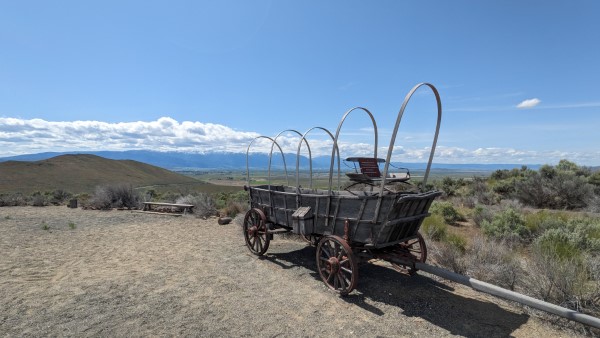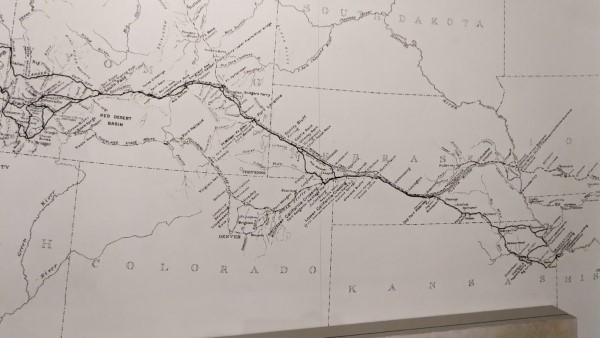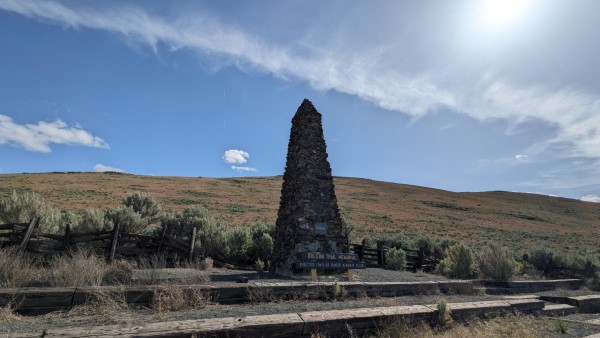May 26, 2024
Written By: J.Couch
Growing up in Oregon and living a lot of my childhood in Oregon City, the end of the Oregon trail, we learned a lot about the history of the Oregon trail and the pioneers that came west to start a new life.
On our trip moving from Denver back to the Pacific Northwest, I kind of felt like one of these pioneers heading west to new adventures in the promised lands. Along the way we stopped at a place in Baker City called National Historic Oregon Trail Interpretive Center. I have been by here multiple times but just never had the time to stop. This time we made a little time to stop.
It’s located up on a hill, about 10 minutes east of the highway in Baker City. Driving up you can see the white buildings up on the peak of the hill. They look kind of tent-like from down below, but I wish that they would have designed them more like wagons coming over the hills. If you ever visit Oregon City, they have another place to visit, the End of the Oregon Trail Interpretive Center. This was designed to look like two wagons, but over time the canvas has been taken off due to the weather.
The admission to get in is not bad, $8 for ages 16 and up. Seniors are $6. But on this weekend, we happened to be here, they had just reopened from a renovation, it was free to get it. They did have a donation box so we donated about the same as it would have cost us to get it.
When you walk in it’s a big open building with a lot of windows and sunlight shining through. They have it set up so you walk through in chronological order that takes you from the pioneers leaving Missouri on their trek west to ending up in Oregon City, the end of the trail. They have settings of full-size wagons, oxen, mules and people on their way across the land. Audio plays in the background with the sounds of animal noises, wagons rolling across the land and people talking. There are lots of sections that you can stop and read however much you want to about different points and situations that they ran into along the way.
There are a few short movies too that show more details of what it would have been like. The hardships that these people endured along the way is incredible. Many people lost their lives to disease, accidents, starvation and violence just to make it to a land of opportunities. In fact, they said 1 out of 10 people died on the trip. On average they walked 15 to 20 miles a day for 5 to 6 months straight, hoping that they would make it before winter set in. Most of the time they walked because the wagon was more a way to haul all the food and supplies and not for the purpose of riding. Just driving from Denver to Portland, stretching it into 3 days seemed like a long way, I can’t imagine 5 to 6 months across rugged land, wild animals, weather issues and lots of unknowns, riding in a wagon or walking beside it.
The view from up here is just as amazing. The snowcapped mountains all around are beautiful. It would have been awe inspiring walking with your group and family across this hill and seeing the vast valley below. It’s awe inspiring just driving up there in a car. From the main building you can take a path down to see where the actual wagon trail came across this area and down into the valley below. You can still see the ruts from the wagon wheels. Putting yourself in the actual spot where thousands traveled here is kind of emotional and makes you appreciate what we have today. I am sure that a hundred plus years from now people will look back and think how hard we had it and what we struggled with, but in reality, you deal with what you are given at the time and make the best of it.
If you are traveling through the Baker City area and if the history of the Oregon trail is appealing to you at all, take an hour or so and stop in to check it out. You won’t be disappointed.
Thanks for wandering with us,
The Wandering Couchs



